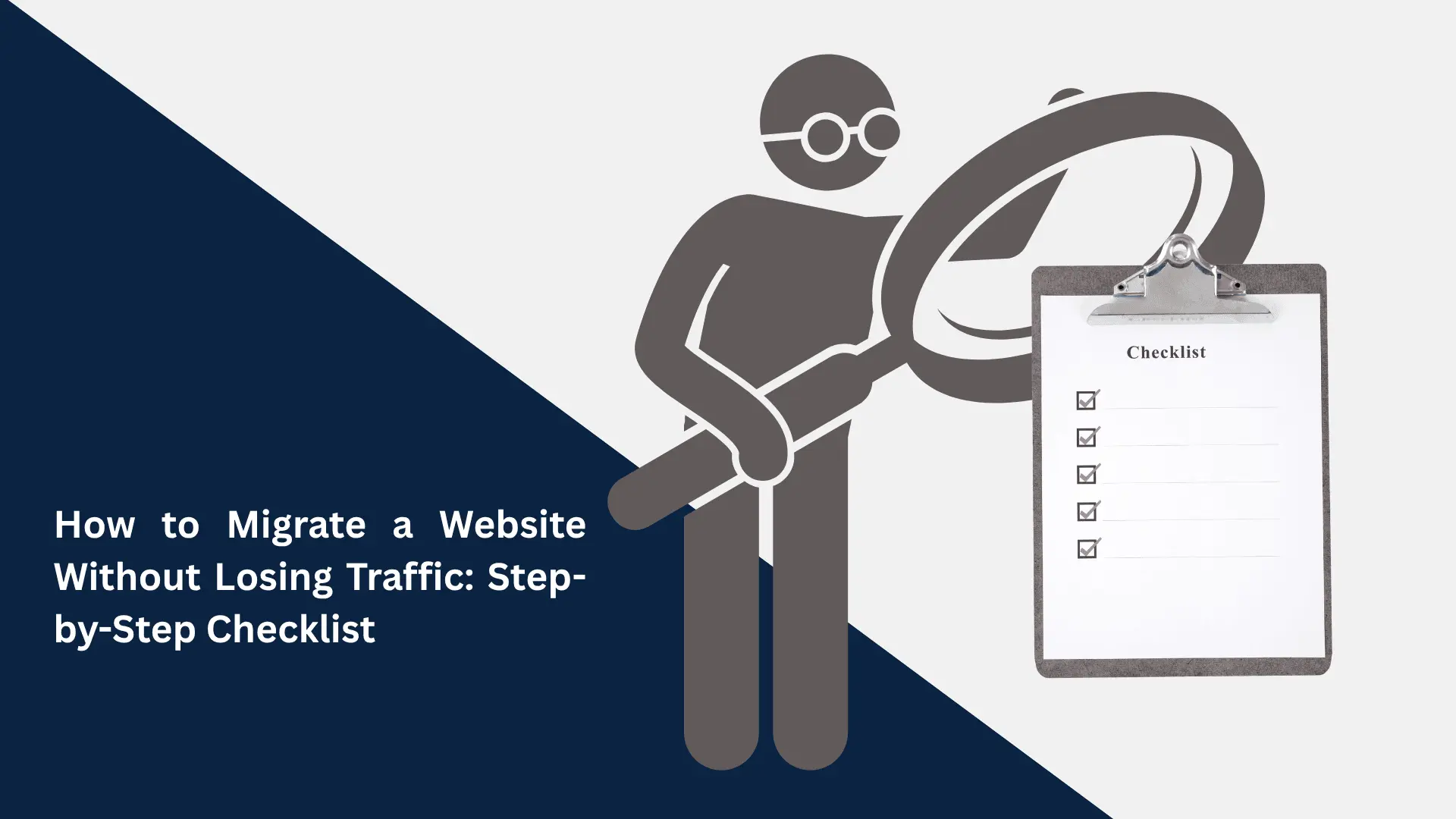You want to migrate your website without losing your website traffic? We made this easy for you! By following this step-by-step seo migration checklist, you can migrate your site smoothly without facing a negative SEO impact and losing audience trust.
Key Takeaways
- Smart migration planning and clear communication can prevent you from site traffic loss.
- A staging environment provides a safer place for your site to test without facing uncertainties.
- Designing URL and redirects mapping accurately protects your SEO efforts.
- Early monitoring and ongoing site analysis of your site helps you avoid chaos..
Introduction
One wrong step! And your website migration can become a nightmare —your potential customers will vanish in thin air, your website rank will drop drastically in search engines, and even your hard earned money will bleed.
This guide will show you how you can exactly migrate your site without sacrificing your website traffic and your search engine visibility.
➯What is Website Migration?
Website migration is not about drastically moving your well running website to a new domain.
This guide will help you to efficiently use your resources that include — your money, your time and team of experts to migrate your website without compromising your site reputation.
Definition and Scenarios (CMS change, domain change, redesign)
Your website migration means the process of doing wide range of changes to a website includes:
- Website domain change— For business rebranding (example.com → example.io)
- Website redesigning and structural change— For better User Experience and good SEO performance. (site URL paths, site layout, taxonomy)
- Website CMS— For better website speed, to get advance features, better user experience or better security (e.g. Shopify → WordPress or WordPress→ Webflow)
- Website Hosting server change— To improve website speed, to scale, and core web vital (e.g. Godaddy → SiteGround)
- Switching site from HTTP to HTTPS— for user encrypted information.
Site migration is a major change that impacts highly how search engines like Google crawl and index your website or to improve user experience.
Any type of migration contains high SEO risks —if you fail to handle them properly then your business site ranking and organic traffic will slip from your hand very fast— just like sand slips from your hand!
| Website migration types | What it is | How it helps |
|---|---|---|
| Domain migration | Migrate a website from one domain to another. | ✯Helps in business rebranding. ✯ To improvise SEO ✯ improve Website operational efficiency. ✯ assist in legal. ✯strengthen website domain authority ✯improves site security |
| Website Redesigning | It helps in renovating your whole website. | ✯ Better website design ✯ Better website structure ✯ Better site performance ✯ User friendly site ✯Rebranding |
| Platform or CMS migration | Shifting of your website from one platform or CMS to another. | ✯ Allows scalability ✯ improve site performance ✯provides more advance features. ✯ Improve site security ✯Improve site speed and user experience |
| Website structural change | It’s the change of your whole site architect. ✯ URL pattern alteration ✯ navigation changing ✯ site internal linking change ✯ site hierarchical change | ✯ Use for E-commerce businesses ✯ improve user experience ✯ improve search engine crawling |
| Site content migration | It includes your website content migration like images, videos, and etc | ✯ Improve content management ✯ better digital asset management. |
| Subdomain or subdirectory | This migration is between site subdomain to subdirectory | ✯ better SEO performance |
| HTTP to HTTPS | It’s known as site protocol change. | ✯ To increase site security ✯ Google ranks HTTPS websites. ✯ Improve site SEO |
➯Why Migrations Go Wrong
Here is why migration of your site can go wrong —and can cost you more than you even think!
Traffic Loss, Broken Links, SEO Drops
- Website missing redirects or incorrect redirects— It causes 404 errors on your site and negatively impacts your SEO efforts.
- Old internal linking— It causes the outdated URLs to redirect to other pages which negatively impacts users’ experience.
- Removing your site’s high performing pages or merging— if you are not using redirects and deleting or merging your well performed site page then it will kill your site SEO and backlinks as well.
- Design tweaks can impact metadata or title tage— this impacts your search engine ranking before you even realize it
➯Importance of a Pre-Migration Checklist
Without setting up a pre seo migration checklist — you are calling disasters and chaos.
Following clear and concise steps can lead to:
- Intact website traffic.
- SEO signals of your website will stay preserved and protected.
- Team work will stay aligned and coordinated
- Setting up clear goals
For this purpose, some tools like screaming frog and Ahrefs provide you with proper facts and evidence so you can avoid guess work — more factual decisions lead to structural work!
Pre-Migration Planning
Here is an expert plan before you start migrating your site.
➯Define the Scope of Migration
To understand scope of migration you need to understand the following:
Full Domain vs Partial Migration
Full Domain migration— It involves migration of your whole website including all of its files, database, and functionalities to a brand new domain name or hosting server.
Partial Migration— It involves transferring some parts of your site like blog section redesign or restructure, While you are leaving other sections of site the same as it is on the original site.
| Migration type | Scope |
|---|---|
| Full Domain migration | ✯High risk while migrating ✯High reward & more benefits ✯Helps you rebrand your business cleanly |
| Partial Domain migration | ✯Low migration risk ✯Safer validation |
If you want to do gradual updates on websites then Google also offers phased rollouts.
➯Conduct a Full Website Audit
Conduct a full in depth website audit:
1. Crawl Your Current Site (Screaming Frog, Sitebulb)
Crawl and audit your entire website by using SEO tools like:
2. Export All URLs and Metadata
Export all your website URL, meta titles, redirects, meta descriptions, code status, and other data elements — it will help you to compare before and after launch of your website data.
➯Benchmark Performance Metrics
Benchmark performance metrics like:
Organic Traffic, Rankings, Site Speed
- Your site organic traffic and impressions.
- Your website top ranking keywords and top ranked pages as well
- Your website core web vitals like site loading speed, mobile responsiveness, data structure.
These performance metrics will let you compare your website before vs after more precisely and accurately.
SEO Preparations
This step is all about making your website ready for search engines like google before you are going to make major website changes.

➯ Map 301 Redirects Carefully
To avoid making broken pages and links, it is important to make a detailed list which is normally called a Redirect Map— It pairs up an old site URL with the new accurate site URL.
Use 301 redirects — it tells search engines that your pages are permanently moved to a new URL. It helps you to preserve your SEO efforts that you did on your old page.
Avoid 404s and Chain Redirects
It is important to make sure that every old site directly leads to a new accurate URL— not by using multiple steps like chain of redirects. Redirect chains like (like A → B → C) confuses your audience and search engines as well. That’s why it’s important to double check your URL by using SEO tools to avoid any uncertainty.
➯ Maintain On-Page Elements
When you are moving or updating your site pages— then make sure your all on page SEO elements stay intact and aligned.
Title Tags, Meta Descriptions, Headers
Your website elements act as your business card for search engines. That’s why it’s important to make sure that these elements must stay accurate and unique from each other.
- Title tags and meta descriptions: Use the previous ones or again optimize them for every single new URL.
- Headers (H1, H2, etc.): Maintain the previous headers or refresh your main headlines so they still show the page’s topic.
- Alt text for images: Preserve ALT texts of website images somewhere to help your SEO efforts and accessibility as well.
If you are migrating your website then make sure these above elements stay aligned, so that your website can index in search engines properly.
➯ Canonical Tags & hreflang Checks
Canonical tags of your website are the HTML signals to tell search engines that this content is the main or original. It is very helpful when same nature of content shows under multiple website URLs
Never use these canonical tags on already redirected pages. As this will confuse search engines more and negatively impacts your SEO efforts.
Hreflang tag is important for websites with multiple languages. It makes sure that the search engine shows the right language version of your website pages. Every page of your website should reference all its variants and to itself as well, it also includes its fallback version as well.
➯ Robots.txt & Sitemap Setup
Your website robot.txt file assists search engines like google bots or crawlers on which page they have to crawl. That is why it’s important to check that you don’t accidentally block your pages you want to be ranked — make sure you add your sitemap link in it as well.
Your website XML sitemap must only list your website’s new URLs only. It’s important for you to submit your updated XML sitemap to your google search console properly. It helps search engines to find and index your site pages in a more efficient manner.
Don’t Block Important Pages
It’s important to double check that your robot.txt file does not block important website content like your website blogs or articles and your service or product pages.
If you are staging your website or new development versions of the site have robot.txt blockage, then solve that blockage before making your site live— because live website content or pages should be crawlable and indexable.
Technical Checklist
Here is the technical seo migration checklist of website migration.
➯ Hosting & Server Configuration
Make sure that the new hosting server you are moving your website to must support:
- HTTPS protocol
- Good website speed
- Supports content delivery network (CDN) configuration
- Provides SSL certificate
- Support seamless DNS setup
- Seamless business E-mail configuration
- Supports third party services.
➯ Set Up the New Site in a Staging Environment
Set up and test new site functionalities in a staging environment— not when it’s live! Audit your website thoroughly, browse it in different places just like a website user, check responsiveness on mobile devices and tabs, and make sure that all the functionalities work properly from metadata to website navigation.
➯ Test Core Web Vitals & Mobile Usability
Analyze your website layout, loading speed, mobile responsiveness thoroughly in a staging environment. Make sure that you fix large media file size or heavy coding scripts before going live.
➯ Validate Internal Links, Menus, and CTAs
While auditing, double check all the internal links, website menu links and call-to-action buttons are working properly and taking the user to the right page.
➯ Set Up Google Analytics & Google Search Console
After setting up now, Add your new website to Google analytics (GA4) and Google search console.
Use Annotations for Date of Migration
Add your GA4 annotations with your website launching date. This makes sure your website tracking shifts more easily and clearly without any chaos.
Launch Day Tasks

➯Launch During Low-Traffic Hours
Launch your website during low traffic hours— because at this time very less users come to your site. This helps you avoid any uncertainty and avoids unpleasant experiences. It also provides you a room to fix small errors or make adjustments without a rush.
➯ Monitor Site Speed and Server Response
After launching your site, immediately monitor site page speed keenly — check how fast these are loading. Also analyse if pages are returning to the server response properly or causing (HTTPS 200 error).
Slowing website loading speed or wrong server response just like 3xx, 4xx or 5xx negatively impacts user experience and ultimately your website SEO is affected.
➯ Verify Redirects & Live URLs
Verify and test all redirects, to make sure they go straight to new URL setups without any disruption— means no chains and no broken site links.
You can randomly check your site URL manually and then also run an in depth audit through crawling tools as we discussed above.
➯ Submit New Sitemap to Google
It is important to submit your new and updated site map to Google search console. As it allows Google to index your site structure quickly.
Never forget to make sure that Sitemap includes a new URL not the old one, and your robot.txt file points to sitemap accurately.
➯ Run a Live Crawl Immediately Post-Migration
Right after website launch, run a live crawling on your new site immediately by using crawling tools. It will help you to find out if your website has any missing meta data, redirect issues, canonical tag issues, or broken link issues on your live site.
Post-Migration Monitoring
After migrating your site it is important to monitor following:
➯ Monitor Traffic and Rankings
After taking your site live, it’s important for you to track and monitor your site’s organic traffic and its ranking in search engines keenly. Compare them to your benchmarks so you can find out any drop in traffic or ranking early to avoid chaos
Use GSC, GA4, and Ahrefs/SEMRush
Use tools like Google Search Console, GA4, and Ahrefs or Semrush to analyse:
- Indexing or crawling status of your site
- Organic traffic and your site conversion rate
- Changes in individual site pages and related queries
➯ Fix Any 404 Errors Quickly
Look actively for any 404 error in your Google search console to fix the errors. You can resolve the errors either by adding right pages or by restoring your old site pages.
➯ Check Indexing Status Weekly
Check your site indexing status in Google search console at least once in a week. Also, make it sure that old site URLs are being removed and new ones are working seamlessly. Also check if the search engine flagged or provided a warning to any page to resolve it.
➯ Continue Updating Internal Links
It’s important to continuously update your site’s internal links that lead the site to old URLs. you can resolve it with time so search engines can crawl your site seamlessly and make sure that broken links cannot slow down your site speed.
Bonus Tips for a Smooth Migration
➯ Communicate Changes to Stakeholders
Clear communication with your team, stakeholders and clients is important —specially inform them about migration timing, site expected down time, or any change in URL structures. It will help you to avoid any uncertainty and to take measurable quick actions if anything goes wrong.
➯ Prepare a Rollback Plan
Before launching your website, it’s important to prepare a rollback plan so you can shift back to your old website quickly if anything goes wrong. Take your site full backup and stay informed about how to shift to your old site safely and quickly as well.
➯ Use Migration Checklists in Project Management Tools
Track your site migration checklist in project management tools like Trello, Jira, and Asana).
This will make sure that nothing will be left behind —from your website redirect mapping to site live crawling and also after launch site monitoring.
Final Thoughts
A thoughtful migration of your website is like rebranding your site. Not starting from scratch but refreshing your site with something very valuable. With proper planning, team, decisions and patience. You can preserve your SEO efforts, your organic traffic and your site ranking for business growth.
What is website migration in SEO?
Website migration in SEO means making major changes to a website that can affect how search engines index and rank it. This includes switching domains, moving from HTTP to HTTPS, changing URL structure, redesigning the site, or moving to a new CMS. During a migration, SEO best practices must be followed to avoid losing traffic or rankings.
How long does a website migration take?
The time depends on the size and complexity of your website. A basic migration may take 2 to 4 weeks, while larger websites can take several months. This includes planning, implementation, testing, and monitoring. Rushing the process can lead to errors and SEO issues, so careful preparation is key.
What are the risks of migrating a website?
Some risks include losing organic traffic, broken links, slow page speed, missing redirects, and drops in keyword rankings. If not done properly, search engines may not recognize the new structure, causing visibility issues. That is why it is important to follow a clear SEO migration checklist and test everything thoroughly.
Will I lose SEO rankings after a migration?
It is possible to see a temporary drop in SEO rankings right after a migration. However, if redirects, internal links, and technical SEO are handled correctly, rankings should recover and may even improve over time. Regular monitoring in Google Search Console helps catch and fix issues early.
How do I create 301 redirects during a migration?
A 301 redirect tells search engines that a page has permanently moved to a new location. During a migration, you should map every old URL to its new version and implement 301 redirects in your site’s .htaccess file or server settings. This preserves SEO value and guides users and search engines to the correct pages.
Should I inform Google about the migration?
Yes. If you are changing domains, use the “Change of Address” tool in Google Search Console to alert Google. Also, submit your new sitemap and monitor indexing status. Keeping Google informed helps speed up the reindexing process and minimizes SEO disruptions.
Can I migrate my website without affecting user experience?
Yes, with proper planning. You can maintain a smooth user experience by avoiding downtime, keeping the site structure logical, and ensuring all pages are redirecting correctly. Also, test everything like forms, navigation, and page speed before and after launch to ensure users can browse without issues.
What tools can help with a website migration?
Several tools can assist with a smooth website migration:
Google Search Console – for monitoring indexing and errors
Screaming Frog – to crawl your site and compare old and new URLs
Ahrefs or SEMrush – to track lost backlinks or keyword changes
Google Analytics – to monitor traffic behavior after migration
Redirect path checkers – to test 301 redirects
Using these tools can help catch mistakes early and protect your SEO performance.

